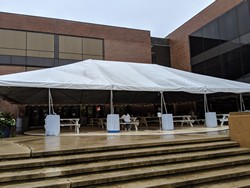The League of Women Voters of New Jersey partnered with the Fair Districts NJ coalition to host a public forum on the legislative redistricting process in New Jersey in the Wilson Auditorium on Wednesday, Feb. 6.
The speakers included Helen Kioukis, Program Associate for League of Women Voters of New Jersey; Patrick Murray, Director of the Monmouth University Polling Institute; and Yurij Rudensky, Redistricting Counsel at the Brennan Center for Justice at New York University School of Law.
This forum is one in a series of 10 public programs being organized by the League of Women Voters across the state in order to educate voters on the redistricting process.
Kioukis, who works to advance statewide legislative priorities and currently serves as the lead organizer for the fairer districts redistricting reform campaign, expressed, “It is important that public opinion drives public policy, especially redistricting reform and how the lines of your (New Jersey) districts will be redrawn after the census.”
Once every decade, census data is collected to determine the redrawing of districts.
However, there are many historically difficult areas to count in New Jersey because less than half of voters are responding to the census which results in an undercount, Kioukis explained. The Supreme Court upholds a principle of “one person, one vote” so that each district needs to be drawn with roughly the same number of people to ensure fair representation, allowing voters equal opportunity to participate in political processes.
Participants responding to the census is important in order to acquire equal representation, but New Jersey is currently struggling with is how fair that representation is along party lines. If the state lacks accurate census data, it risks the number of representatives New Jersey sends to the House of Representatives, based off of Congressional districts, as well as $17.5 million of federal funding for state programs.
Murray, who was named the University’s Polling Institute’s founding Director in 2005 and serves as a federal exit poll analyst during federal election years, explained that legislative redistricting is currently done by legislators, so whichever party in control determines how the map looks.
He added that New Jersey is structured differently. In the 1960s, New Jersey had 21 state senators: one for each county.
This set-up was a clear violation of the “one person, one vote” rule, so the Supreme Court determined that New Jersey needed to change how they drew districts.
Following this decision, a constitutional convention was held, and the result was a bipartisan commission process. Both the Democratic and Republican Party Chairmen would each appoint five members to this commission and by majority vote would determine a new map.
By federal law, when the commissioners are appointed, they must represent the geography of the state.
In 1981, this approach failed so the Chief Justice appointed a tie-breaker. This created a new issue because even if the individual isn’t affiliated with a party, bias would be present in the form of partisan ideology.
Further issues facing legislators in New Jersey include that they have one month to draw the map, with an immense amount of data to consider. Commissioners have got to be fair with respect to federal voting acts, but “there are no community written standards,” said Murray.
Rudensky, whose expertise lies in his civil rights, economic justice impact litigation, and policy advocacy, explained that each state struggles with their own personal issues regarding redistricting.
There are common principles that states should embody when changing their process, but “there’s no one size fits all.” Rudensky said, “[There are] state-specific issues that may arise [in New Jersey], that might not occur other places.”
One way of achieving this is the proposed independent redistricting model that seeks to limit the role that elected officials in selecting commissioners. It began in Arizona and was passed through a citizen initiative process. California, Michigan, and Colorado have also joined their ranks, Rudensky explained.
The process works by voters submitting applications to the state auditor’s office, who then goes through applications with qualification parameters. They screen applications, creating pools of Democrats, Republicans, and Independents that gets sent to legislative leadership who can exclude a certain number of people and then there is a random drawing.
Rudensky confirmed that reform in California was an “enormous success,” creating “partisan balance and including unaffiliated voters as well.”
In order to enact reform in New Jersey, Kioukis said, “Public participation is so important in this process. The voters know their community best although some would argue the legislators do. Voters know who they want to be grouped with for representational purposes.”
“How districts are drawn is integral to the level of representation that we receive,” said Murray.
He believes that students don’t vote because they don’t feel connected to a community. In order to effect change, Murray recommends that students write into the state legislators who control this process.
“New Jersey does not have an initiative referendum; we cannot get a bunch of voter signatures and put something on the ballot,” Murray explained.
He said, “It has to be done through the state legislator and they won’t do anything that undermines their power. To effect change you have to make your voice known to them.”
PHOTO COURTESY of Monmouth University



